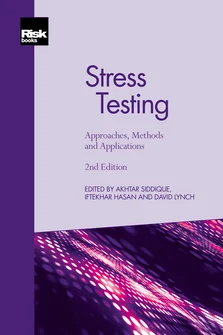Foreword
Foreword
Foreword
Introduction
Response to Financial Crises: The Development of Stress Testing over Time
Stress Testing and Other Risk Management Tools
Econometric Pitfalls in Stress Testing
Stress-testing applications of Machine Learning Models
Four Years of Concurrent Stress Testing at the Bank of England: Developing the Macroprudential Perspective
Stress Testing for Market Risk
The Evolution of Stress Testing Counterparty Exposures
Liquidity Risk: The Case of the Brazilian Banking System
Operational Risk: An Overview of Stress-testing Methodologies
Peacetime Stress Testing: A Proposal
Stress-test Modelling for Loan Losses and Reserves
A New Framework for Stress Testing Banks’ Corporate Credit Portfolio
EU-wide Stress Test: The Experience of the EBA
Stress Testing Across International Exposures and Activities
The Asset Market Effects of Bank Stress-test Disclosures
An Alternative Approach to Stress Testing a Bank’s Trading Book
Determining the Severity of Macroeconomic Stress Scenarios
Governance over Stress Testing
The evolution of stress testing in financial services has been fascinating. In the beginning, the set of methods that we call stress testing were best described as an acknowledged tributary of the broader river of risk management, although somewhat of a backwater. Such methods received limited attention, and in many cases the results of stress tests were regarded as interesting curiosities – a supplement to other, more prominent methods of assessing risk, but perhaps more of an entertaining novelty than a critically important tool.
Then came the global financial crisis, and stress became a real and immediate concern. Stress scenarios that once appeared plausibly severe no longer seemed all that stressful. Scenarios viewed as unrealistically stressful came to look plausible. And the tool of stress testing, which had seemed of secondary importance, began to be put to new and critically important uses. In effect, stress-testing methods were subjected to their own stressful test. The heightened focus revealed that much of the data and many of the methods underlying stress-testing tools were not adequate for the new post-crisis uses. Models and results were not very robust, and
Copyright Infopro Digital Limited. All rights reserved.
As outlined in our terms and conditions, https://www.infopro-digital.com/terms-and-conditions/subscriptions/ (point 2.4), printing is limited to a single copy.
If you would like to purchase additional rights please email info@risk.net
Copyright Infopro Digital Limited. All rights reserved.
You may share this content using our article tools. As outlined in our terms and conditions, https://www.infopro-digital.com/terms-and-conditions/subscriptions/ (clause 2.4), an Authorised User may only make one copy of the materials for their own personal use. You must also comply with the restrictions in clause 2.5.
If you would like to purchase additional rights please email info@risk.net











